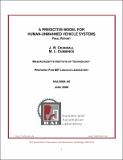| dc.contributor.author | Crandall, J. W. | |
| dc.contributor.author | Cummings, M. L. | |
| dc.contributor.other | Massachusetts Institute of Technology. Dept. of Aeronautics and Astronautics. Humans and Automation Laboratory | |
| dc.date.accessioned | 2009-09-18T04:39:11Z | |
| dc.date.available | 2009-09-18T04:39:11Z | |
| dc.date.issued | 2008 | |
| dc.identifier.uri | http://hdl.handle.net/1721.1/46744 | |
| dc.description.abstract | Advances in automation are making it possible for a single operator to control multiple unmanned
vehicles (UVs). This capability is desirable in order to reduce the operational costs of human-UV systems
(HUVS), extend human capabilities, and improve system effectiveness. However, the high complexity
of these systems introduces many significant challenges to system designers. To help understand and
overcome these challenges, high-fidelity computational models of the HUVS must be developed. These
models should have two capabilities. First, they must be able to describe the behavior of the various
entities in the team, including both the human operator and the UVs in the team. Second, these models
must have the ability to predict how changes in the HUVS and its mission will alter the performance
characteristics of the system. In this report, we describe our work toward developing such a model. Via
user studies, we show that our model has the ability to describe the behavior of a HUVS consisting of a
single human operator and multiple independent UVs with homogeneous capabilities. We also evaluate
the model’s ability to predict how changes in the team size, the human-UV interface, the UV’s autonomy
levels, and operator strategies affect the system’s performance. | en |
| dc.description.sponsorship | Prepared for MIT Lincoln Laboratory | en |
| dc.language.iso | en_US | en |
| dc.publisher | MIT Humans and Automation Laboratory | en |
| dc.relation.ispartofseries | HAL Reports;HAL2008-05 | |
| dc.title | A Predictive Model for Human-Unmanned Vehicle Systems : Final Report | en |
| dc.type | Technical Report | en |
